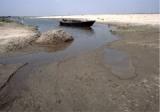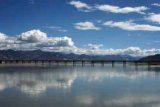Archives
Children of the damned
 They are concerned over the new Chinese anti-drought project, which envisages the diversion of the Brahmaputra to the arid Xinjiang and adjoining region where close to ten million people face water shortage. Although Beijing has assured the two Governments that there will be no negative impact on the ecosystem in the central basin or downstream areas of the river, the genuine fear of the millions of people who live along its course and are dependent on it for their livelihood can not be brushed aside. In November last year, China announced a first project concerning the construction of a dam on the Tsangpo which is the upperreaches of the rahmaputra for creating the world’s largest hydroelectric plant with a capacity of 510 MW. However, this new plant is causing concern in India and Bangladesh. Some Indian satellites have photographed the construction of several dams along the ributaries of the
They are concerned over the new Chinese anti-drought project, which envisages the diversion of the Brahmaputra to the arid Xinjiang and adjoining region where close to ten million people face water shortage. Although Beijing has assured the two Governments that there will be no negative impact on the ecosystem in the central basin or downstream areas of the river, the genuine fear of the millions of people who live along its course and are dependent on it for their livelihood can not be brushed aside. In November last year, China announced a first project concerning the construction of a dam on the Tsangpo which is the upperreaches of the rahmaputra for creating the world’s largest hydroelectric plant with a capacity of 510 MW. However, this new plant is causing concern in India and Bangladesh. Some Indian satellites have photographed the construction of several dams along the ributaries of the  river. Some experts assert that the very minor deviation of these courses will slow the flow of the Brahmaputra causing damage to local populations as in the case of dams on the Mekong River known as the Lancang in China. It is the heart and soul of mainland Southeast Asia. Over 60 million people depend on the river and its tributaries for food, water, transport and many other aspects of their daily lives.
river. Some experts assert that the very minor deviation of these courses will slow the flow of the Brahmaputra causing damage to local populations as in the case of dams on the Mekong River known as the Lancang in China. It is the heart and soul of mainland Southeast Asia. Over 60 million people depend on the river and its tributaries for food, water, transport and many other aspects of their daily lives.
 China’s plans for a dam on the Yarlung Tsangpo River, high up on the Tibetan plateau, continue. Beijing can however expect staunch opposition from India where the river is known as the Brahmaputra and is crucial for farming and the lives of millions of people. Hydro-electrical engineers have been hard at work building a dam on the highest river of the world. Its project cost is estimated at 1.2 billion USD and once complete it will have 85 Megawatt units totaling 510 MW. The first unit is expected to be commissioned by 2014 for providing power to central Tibet. For its part, India is deeply concerned that China might reduce the flow of water on its territory, negatively affecting millions of people. NewDelhi has reason to be concerned since it has not been taken into account by Beijing in the latter’s plan to construct dams.This is evident from the fact that the number of dams to be built by China has not been revealed to India. Some have suggested that there could be at least five dams. There is deep concern in Assam over the reported dam being built by the Chinese on the Brahmaputra river, at its source in Tibet. Assam Chief Minister Tarun Gogoi has directed the State’s Chief Secretary to constitute an experts’ Committee headed by Dr. Dulal Chandra Goswami, former Professor of Guwahati University, to examine issues like water availability, hydroelectric potential scenario, flood and related issues such as erosion, sedimentation load, etc in the light of the Chinese decision to divert water from the Brahmaputra.
China’s plans for a dam on the Yarlung Tsangpo River, high up on the Tibetan plateau, continue. Beijing can however expect staunch opposition from India where the river is known as the Brahmaputra and is crucial for farming and the lives of millions of people. Hydro-electrical engineers have been hard at work building a dam on the highest river of the world. Its project cost is estimated at 1.2 billion USD and once complete it will have 85 Megawatt units totaling 510 MW. The first unit is expected to be commissioned by 2014 for providing power to central Tibet. For its part, India is deeply concerned that China might reduce the flow of water on its territory, negatively affecting millions of people. NewDelhi has reason to be concerned since it has not been taken into account by Beijing in the latter’s plan to construct dams.This is evident from the fact that the number of dams to be built by China has not been revealed to India. Some have suggested that there could be at least five dams. There is deep concern in Assam over the reported dam being built by the Chinese on the Brahmaputra river, at its source in Tibet. Assam Chief Minister Tarun Gogoi has directed the State’s Chief Secretary to constitute an experts’ Committee headed by Dr. Dulal Chandra Goswami, former Professor of Guwahati University, to examine issues like water availability, hydroelectric potential scenario, flood and related issues such as erosion, sedimentation load, etc in the light of the Chinese decision to divert water from the Brahmaputra.| Some experts fear that the construction of the dam may trigger devastating floods in Assam during the rainy season and dry up the river in winter. |
Besides Goswami as Chairman, the committee will comprise Jogendra Nath Sarma, Professor of Dibrugarh University, Anup Kumar Gogoi, Professor IIT, Guwahati, Arup Kumar Sarma, Professor IIT, Guwahati and Dr. Bipul Talukdar, Professor, Assam Engineering College, as its Members. The Secretary, Water Resources Department, will be the Member Secretary. The Committee will submit its report within three months from the date of issue of the notification. Chief Minister Gogoi has taken up the matter with the Prime Minister Manmohan Singh and the Union Water Resources Minister Pawan Kumar Bansal during his recent visit to Delhi. China’s decision to construct this dam on the main channel of the Brahmaputra in the upper reaches of Tibet to generate electricity is bound to jeopardize the flow of the Brahmaputra, the lifeline of the Assam valley.
The Minister for External Affairs SM Krishna has assured the Assam Chief Minister that there is no cause for alarm in this regard. What is the basis of his optimism? Tarun Gogoi has rightly conveyed fears that the reported diversion of water from the river by China might adversely affect the interests of Assam which depends on the waters of the Brahmaputra. The Minister for External Affairs told Mr. Gogoi that the Chinese have assured India that they are constructing only a small run-of the river hydro project which will not affect the flow of water in the river in Assam and other lower riparian states.
Besides the assurance given by Beijing, the government has ascertained the factual position on the issue. The External Affairs Minister said that the Government is in constant touch with Chinese authorities over the issue and it would never overlook any development that would harm the interests of the state or any other part of the country. Meanwhile, some experts fear that the construction of the dam may trigger devastating floods in Assam during the rainy season and dry up the river in winter. Some academics assert that India has accelerated construction of a large number of dams on the Brahmaputra in Arunachal Pradesh near its border with China to secure first-use rights over the waters of the river.
Fan Xiao, a Sichuan based geologist, warns that the Yarlung Zangbo River dam project is very likely the first in a series. Beijing in fact appears hell bent on damming all of Tibet’s main rivers. However, Fan is concerned because such plans are driven by short term economic considerations and that this frenzy will have long term environmental, political and international consequences. Some reports have suggested that electricity generated from the Zangmu plant would help meet the growing demand in Guangdong and Hong Kong and that it could be sold to countries like Myanmar, Thailand and Bangladesh. But what will millions of people in India and China will do with electricity if the Brahmaputra dries up? The Chief Minister should not rest assured after the assurance he has received from the Minister for External Affairs. He should be more watchful and put a special team in place to collect information on the Chinese motive on a day to day basis. It may not be prudent to solely rely on the beleaguered Government in Delhi to save the mighty river.

